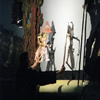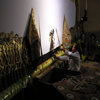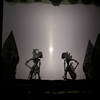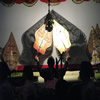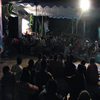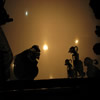Performance
Wayang kulit performances are grand events that last throughout the night, accompanied all the while by a live gamelan orchestra. In village settings, hundreds of people may gather to watch.
Performances occur for a wide variety of reasons. They can commemorate an important event such as a birth or marriage, kick off a political campaign, or simply entertain. The particular story presented and messages conveyed are usually relevant to the event. A performance celebrating a birth might tell a story about the birth of a heroic character.
Traditionally, wayang kulit performances can be viewed from two sides of the screen – the “shadow side” and the “dhalang (puppeteer) side.” In the past, people typically watched from the shadow side. Today, performances are set up for the audience to watch from the dhalang’s side of the screen. People usually walk around to the shadow side to catch a glimpse of the dancing shadows without the distraction of the dhalang, the puppets, and the gamelan orchestra. Yet, even when the shadow side is not accessible, shadows still play an integral role in the performance.
Wayang kulit performances are elaborate affairs. The ability to sponsor an event usually reflects a high social status but village performances are characteristically open to the public. Today, when staged at more elite venues, they are often broadcast on radio or television, still providing access to a great number of people. Regardless of sponsorship and venue, wayang kulit remains very much an art of and for the people.
Elements of a Performance
The fundamental components of a performance include:
- the puppeteer, dhalang
- a mallet used by the dhalang to knock on the puppet box, cempala
- metal plates that the dhalang hits with his foot, kepyak
- a traditional Indonesian orchestra, gamelan
- shadow puppets, wayang kulit
- a light source, blencong
- female singers and a male chorus, pesindhen and penggerong
- a screen frame and screen, gawang and kelir; the main focus of the performance
- banana logs, gedebog; the pointed sticks of the wayang base handle pierce the peeled trunk of a banana tree and the spongy substance holds the puppets in place
- a puppet box, kothak



